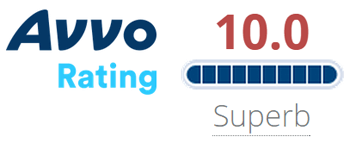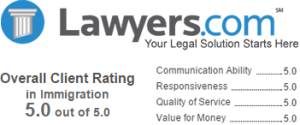
Our globe is shrinking.
Multinational trade agreements and advances in technology, transportation and communications have blurred the lines between nations to create a global marketplace facilitating the movement of both goods and services. The development of an international labor pool means that the most unique and talented professionals born in one country, may be educated and trained in another, and employed wherever their skills are most in demand.
Savvy employers have learned that, for their U.S. business or industry to compete in the international marketplace, they must recruit the best and brightest professionals irrespective of their countries of birth. As rich and varied as our domestic workforce may be, it simply cannot satisfy business needs in every instance — especially when an increasing percentage of leading graduates in the sciences and technology in top U.S. universities are foreign-born.
Client Reviews

Legal Guru in All Things Immigration
“Mr. Shusterman and his law firm have represented my family and me very successfully. He is not only a legal guru in all things immigration but even more so he is an exceptional human being because he empathizes with his clients and cares that justice is done.”
- Maria Davari Knapp, Chicago, Illinois
Read More Reviews
Zoom Consultations Available!
CHECKS AND BALANCES
This need for knowledge, skills, and talents that are not readily available in the domestic labor market creates a tension between U.S. employers and U.S. workers — employers are eager to fill critical positions with the most qualified individuals, while workers seek guarantees that they will not displaced by lower paid or less qualified employees. This tension has been illustrated in a number of highly-publicized stories, from the ongoing NAFTA debate to the need for the U.S. to compete successfully with Japan and the European Common Market.
Fortunately, U.S. immigration law is consciously designed to serve the interests of both employers and workers. On the one hand, there are avenues through which employers can petition for a limited number of foreign-born workers. This ability was enhanced by the passage of the Immigration Act of 1990 which streamlined immigration procedures for employers and increased the number of employment-sponsored immigrants from 54,000 to 140,000 annually. On the other hand, our immigration laws protect U.S. workers by restricting employment-based immigration to workers whose skills and expertise are otherwise unavailable in the domestic workforce.
The protective mechanism used to guard the interest of U.S. workers is called “labor certification,” a process whereby employers demonstrate to the government that U.S. workers will not be harmed by the employment of a foreign worker. This process, which has been in existence for about thirty years, is often cumbersome and forces employers to duplicate, at considerable expense, previous recruitment efforts.
Fortunately, under the provisions of the Immigration Act of 1990, depending on the position to be filled, a knowledgeable employer may recruit and hire various categories of highly-skilled individuals from the international labor pool without having to undergo the labor certification process.
WHAT IS LABOR CERTIFICATION?
The decision to petition for a foreign-born professional does not come easily to most U.S. employers. Employers are wary of the additional costs of international recruitment, worried about the problems inherent in integrating a foreign-born individual into their workforce, and are not fully informed concerning applicable immigration laws and procedures. For the most part, U.S. employers decide to petition for an immigrant worker only after an extensive, and unsuccessful, recruitment process in the domestic labor market. A number of health care facilities in rural, medically underserved areas, after months and even years of attempting to attract U.S. physicians, have successfully utilized the labor certification process to hire Canadian doctors eager to practice in the U.S.
As a matter of law, an alien seeking to permanently enter the U.S. in order to work is not admissible unless the Department of Labor certifies that the alien worker will not displace (in other words, there are no U.S. workers who are able, willing, qualified, and available to perform the job) nor adversely affect the wages and working conditions of U.S. workers who are similarly employed. The employer must file an application with the Department of Labor establishing both of these criteria have been met.
The application form. The application (Department of Labor form ETA 750) consists of two parts: Part A which describes the job offered, the minimum job requirements, and the salary, and Part B which describes the experience and education of the worker being applied for. Through this application, the employer is guaranteeing that it will satisfy all the regulatory requirements for labor certification: (1) it can pay the offered wage, (2) the wage offered equals or exceeds the prevailing wage and that the wage at the start date will equal or exceed the prevailing wage at that time, (3) the wage offered is not based on commissions or bonuses (unless the employer guarantees the base wage), (4) the employer will be able to place the alien on the payroll on or before the date that the alien enters the United States, (5) the job opportunity does not involve unlawful discrimination, (6) the job is not available because of a strike or lockout, (7) the terms, conditions, and environment of the job are not contrary to law, and (8) the job opportunity has been and is clearly open to any qualified U.S. worker.
The labor certification application is filed with a state employment security agency (SESA) — in California, the Employment Development Department (EDD) — which reviews the application for completeness, dates it, and assesses whether the wage being offered and the designated requirements are appropriate. Based on this review, the state office instructs the employer how to go about recruiting U.S. workers. Because the regulations require a fairly specific and extensive recruitment process, it is likely that any previous recruitment efforts will be deemed insufficient by the Labor Department.
Recruitment. There are three basic components to recruitment. First, the employer must place a job order with the state office for at least 30 days. Second, the employer must post a notice at the worksite for at least 10 consecutive business days, notifying existing employees of the job opportunity. Third, the employer must advertise in a medium that will publicize the offer of employment — three days in a local newspaper of general circulation or once in an issue of a journal that reaches persons seeking job opportunities in a particular occupation or profession. It is the government, not the employer, which designates the appropriate publication. To supplement this procedure, the Immigration Act of 1990 provides that employers must notify bargaining representatives (or, if there is no bargaining representative, the workforce at large, through a conspicuous posting) of its intent to apply for a labor certification. As is apparent from the extensive recruitment requirements, all U.S. workers who apply must be seriously considered — the employer is obligated to solicit additional information from any U.S. worker who, on paper, appears even minimally qualified.
The administrative machinery. Within 45 days of receiving instructions from the state office, the employer must report the results of its recruitment efforts to the state. The state agency forwards the labor certification application to a certifying officer in one of the ten regional offices of the U.S. Department of Labor. Once there, the certifying officer may approve the application, request more information, or issue a “Notice of Findings” (NOF) that flags defects in the application and provides the employer with a 35 day grace period to cure.
If the certifying officer denies the application, the employer may appeal the denial to the Board of Alien Labor Certification Appeals (BALCA). BALCA was created to assure consistency in labor certification adjudications throughout the U.S. If an employer appeals a denial, BALCA will review the application for labor certification, de novo if it so chooses, and may either affirm or reverse the denial or remand the case with instructions to the certifying officer.
If an application is approved, the position is certified and the certification valid as long as the job is available. At that point, the employer may petition the Immigration and Naturalization Service (INS) for an employment-based classification for its prospective employee. INS can still deny the petition, the labor certification notwithstanding, if the offer of employment or the worker’s qualifications do not satisfy appropriate legal criteria.
THE QUIRKS OF LABOR CERTIFICATION
There is an art to completing a labor certification application, and it takes determination to see the process through, because the certification procedure is so byzantine in construction: The employer has to prove a negative (namely, demonstrate that there are no U.S. workers to take a job), follow instructions from a state office (that may know little or nothing about its operations or product) regarding how to recruit for its own job vacancy, and convince government officials on both the state and federal levels that its recruitment efforts have been adequate. Labor certification, without guidance, is not for the uninitiated.
Yet despite the complexities inherent in the labor certification process, thousands of applications are approved each year. An employer who is about to submit an application for alien labor certification must remember one simple tenet — the normal business rules in recruiting do not apply. For example, the Department of Labor publishes the Dictionary of Occupational Titles (DOT), that purports to list every job existing in the United States. It categorically breaks down occupations according to a number of indices — education, experience, physical activity, etc., and for the Labor Department’s purposes, all employment opportunities fall within one code or another of this dictionary. The labor certification process prohibits any “mixing and matching” of duties to create a new occupation, no matter how appropriate or legitimate. Thus an employer must shape a job title and description to correspond to one of the DOT codes.
Another oddity about the labor certification process is that it runs counter to the merit system. DOL regulations seek to protect U.S. workers by ensuring that an employer does not draft a job description to circumvent the hiring of qualified U.S. workers. All job requirements must be fairly standard for the job opening and may not impose any unduly restrictive requirements, lest U.S. workers be discouraged from applying. Extrapolating from this requirement, the Labor Department has fashioned a rule that runs counter to good business sense — the employer must take a minimally-qualified U.S. worker over a foreign worker with superior skills. This requirement is construed so that a U.S. worker does not even have to meet the minimum qualifications for the job if DOL determines that some other combination of training, experience, and education will satisfy them. Similarly, a U.S. applicant cannot be rejected for wont of a credential not appearing verbatim in recruitment ads. The employer must hire what it advertises, and any discrepancies are construed against the foreign worker. Employers have to be mindful that the burden of proof in the labor certification process is always on them.
The Department of Labor also deviates from standard business practice by requiring employers to post the wage being offered . Many employers do not want wages made a matter of public record, much less public display. To accommodate employer’s discomfort with the posting requirement, the Labor Department now permits employers to post a range of wages. Nonetheless, though the offered wage is masked in a range, the bottom of the range itself must be within 5% of the prevailing wage.
ALTERNATIVES TO LABOR CERTIFICATION
Schedule A
The Department of Labor concedes that the labor certification process may be expensive, burdensome, and time-consuming. It estimates that the nationwide average for labor certification processing is about nine months. The administrative requirements of the process are almost as burdensome for the government as they are for the employer.
To help alleviate this burden, the Labor Department may designate certain occupations which it determines are chronically short of workers and exempt employers of such workers from the labor certification process. Shortage occupations are listed on the Labor Department’s “Schedule A, Group I.” At present, Group I lists only two “precertified” occupations: registered nurses and physical therapists, thus relieving hospitals and other health-care providers of the labor certification burden in hiring individuals in these occupations.
Schedule A also contains a “Group II,” which consists of positions requiring aliens of exceptional ability in the sciences or arts (which includes college or university teachers but not performing artists). Aliens falling within this Group II must satisfy at least two of seven criteria to establish that they are “exceptional.”
While these blanket precertifications are established by Labor Department regulations, it is the INS which makes the determination of whether an individual case qualifies. In Schedule A cases, forms ETA-750A and B are filed directly with the INS along with an immigrant visa petition. Employers are not, however, exempt from all labor certification duties — even when a position falls within the listings of Schedule A, the employer must still post notice of the opening and notify the proper governmental authorities.
New Employment-Based Categories
After observing employer’s frustrations for over a quarter century, Congress concluded that the labor certification process should be streamlined, especially for top professional positions. The Immigration Act of 1990 rewrote much of our employment-related immigration provisions. That law created a new classification scheme for employment-based immigrants and exempted many of them from the labor certification process.
The exempt categories are reserved for the best, the brightest, the specially-qualified, and the unique. Employers are only beginning to learn and appreciate the significant distinctions between the new classifications, and attorneys who represent employers should be aware that their clients can benefit from familiarity with the new immigration law.
Gone are the old immigration groupings. In place of the “third” (professional) and “sixth” (skilled and unskilled) preferences, there are now five “employment-based” or EB categories: EB-1 (priority workers), EB-2 (workers with advanced degrees or with exceptional ability), EB-3 (professionals, skilled workers, and unskilled workers), EB-4 (special immigrants, mostly ministers and religious workers), and EB-5 (investors). Of primary importance to employers, only two of these five categories — EB-2 and EB-3 — require labor certification.
The fifth category, investors, is not so much an employment-based category as an employment-creating one. EB-5 is reserved for would-be immigrants who invest $1 million (or $500,000 in rural or high-unemployment areas) to create ten or more jobs for U.S. workers. In essence, there is nothing to certify.
The fourth category, created for ministers and religious workers, replaces the labor certification requirement with a requirement of demonstrated affiliation with the employer. The value of a minister or religious worker is arguably unquantifiable, and a position with a church or other religious organization, at least in the abstract, is not appropriate for labor certification.
The remaining exempt category is the prized EB-1 class — priority workers. Some have nicknamed the EB-1 class “Einstein visas” because they are earmarked for high calibre professionals. Others call it the “Michael visa,” because it is the one category in which Michael Jordan, Michael Jackson, and Michelangelo would all fit. However whimsical the characterization, the priority worker classification is aptly named because the special skills, talents, or accomplishments of these aliens make them so valuable that labor certification would be a foregone conclusion.
Priority workers are broken down into three subcategories — aliens of extraordinary ability, outstanding professors and researchers, and certain multinational executives and managers.
By definition, an extraordinary ability worker is one who belongs to that “small percentage” that have “risen to the very top of the field of endeavor.” In fact, aliens qualifying for this category are so unique that they do not even require a job offer to enter the country. The statute requires that the alien’s admission substantially benefit the United States. The documentation requirements are demanding. The worker must generally satisfy at least three of the following ten criteria: (1) Documentation of the alien’s receipt of lesser nationally or internationally recognized prizes or awards for excellence in the field of endeavor; (2) Documentation of the alien’s membership in associations in the field for which classification is sought, which require outstanding achievements of their members, as judged by recognized national or international experts in their disciplines or fields; (3) Published material about the alien in professional or major trade publications or other major media, relating to the alien’s work in the field for which classification is sought. Such evidence shall include the title, date, and author of the material, and any necessary translation; (4) Evidence of the alien’s participation, either individually or on a panel, as a judge of the work of others in the same or an allied field of specification for which classification is sought; (5) Evidence of the alien’s original scientific, scholarly, artistic, athletic, or business-related contributions of major significance in the field; (6) Evidence of the alien’s authorship of scholarly articles in the field, in professional or major trade publications or other major media; (7) Evidence of the display of the alien’s work in the field at artistic exhibitions or showcases; (8) Evidence that the alien has performed in a leading or critical role for organizations or establishments that have a distinguished reputation; (9) Evidence that the alien has commanded a high salary or other significantly high remuneration for services, in relation to others in the field; or (10) Evidence of commercial successes in the performing arts, as shown by box office receipts or record, cassette, compact disk, or video sales.
The exemption from the labor certification process for companies who hire extraordinary individuals has been significant. Recently, when a major biotechnology company sought to petition for priority worker status for a scientist who had developed a novel process for mass-producing white blood cells to aid chemotherapy patients in resisting infections, the entire green card process was reduced from 18 months to less than half that time. As a result, many lives were saved and hundreds of new jobs were created for U.S. workers.
The second subcategory — for professors and researchers — requires the alien to be internationally recognized as outstanding in his or her specific academic area and to meet certain other requirements (such as three years teaching or researching experience in the field and arriving to take a tenure or tenure- track position). These workers need only satisfy two of the following criteria: (1) Documentation of the alien’s receipt of major prizes or awards for outstanding achievement in the academic field; (2) Documentation of the alien’s membership in associations in the academic field which require outstanding achievements of their members; (3) Published material in professional publications written by others about the alien’s work in the academic field. Such material shall include the title, date, and author of the material, and any necessary translation; (4) Evidence of the alien’s participation, either individually or on a panel, as the judge of the work of others in the same or an allied academic field; (5) Evidence of the alien’s original scientific or scholarly research contributions to the academic field; or (6) Evidence of the alien’s authorship of scholarly books or articles (in scholarly journals with international circulation) in the academic field. Private companies may petition for a researcher if they have at least three full-time research employees and are themselves accomplished in the field. Interestingly, the statute does not require a Ph.D. or the equivalent to qualify.
The third subcategory — for multinational executives and managers — is perhaps the most often utilized by employers. The immigrant must have been employed in a managerial or executive capacity for at least one out of the past three years. The past employment must be with the same employer, an affiliate, or a parent or subsidiary. The petitioning employer must have been doing business in the United States for at least a year. The Immigration Act of 1990 added increased flexibility to the definitions of executive and manager. Possession of a university degree is not required to qualify under this category.
Many employers would, no doubt, prefer to classify their prospective employees as priority workers and be exempt from the labor certification requirement. However, in reality, more job candidates will qualify under the second category, workers with exceptional ability, or those in possession of an advanced degree. For purposes of the EB-2 category, possession of an advanced degree includes those holding a bachelor’s degree plus five years of progressive professional experience. For these employers, there is an exception to the labor certification process in some cases. Even if a worker is exceptional or hold an advanced degree, he is not properly classifiable under the EB-2 category unless the offer of employment requires a person of such caliber.
A limited exception to the labor certification requirement exists for EB-2 workers whose entry to the U.S. would be “in the national interest.” Neither statute nor regulation defines what the national interest means in this instance. However, in a recent case, the Administrative Appeals Unit (AAU) of INS set forth the following seven factors which may be considered in defining national interest: Would the alien’s employment (1) improve the U.S. economy, (2) improve the wages and working conditions of U.S. workers, (3) improve education and training programs for U.S. children and under-qualified workers, (4) improve health care, (5) provide more affordable housing for young and/or older poorer U.S. residents, (6) improve the environment and make more productive use of natural resources, or (7) did the alien come at the request of a U.S. Government agency? In this instance, the AAU was satisfied by the alien’s employment resulting in the reopening of a plant that created important local employment. While this area is still in its nascent stages, the national interest waiver has already proven to be an important tool for employers seeking to hire exceptional workers and workers with advanced degrees.
Originally, many practitioners assumed that the national interest provisions of the 1990 law would be interpreted narrowly by the Immigration Service, and would require the intervention of an agency of the federal government. However, more recently, an affirmative action counselor at a local community college was successful in obtaining a national interest waiver despite the absence of any sponsorship by a federal agency. Prior law would not have permitted the employment of the counselor since internal policies did not permit the college to modify their hiring practices to conform with the Labor Department’s recruitment requirements for labor certification cases.
CONCLUSION
The Immigration Act of 1990 has dramatically altered employment- based immigration. The rules have changed, the categories revised, and employers now have new, streamlined options for sponsoring the specially qualified foreign-born worker. Once counsel is familiar with these changes, the new laws and procedures can be used to help clients secure the best and brightest workers available in the international labor pool.








